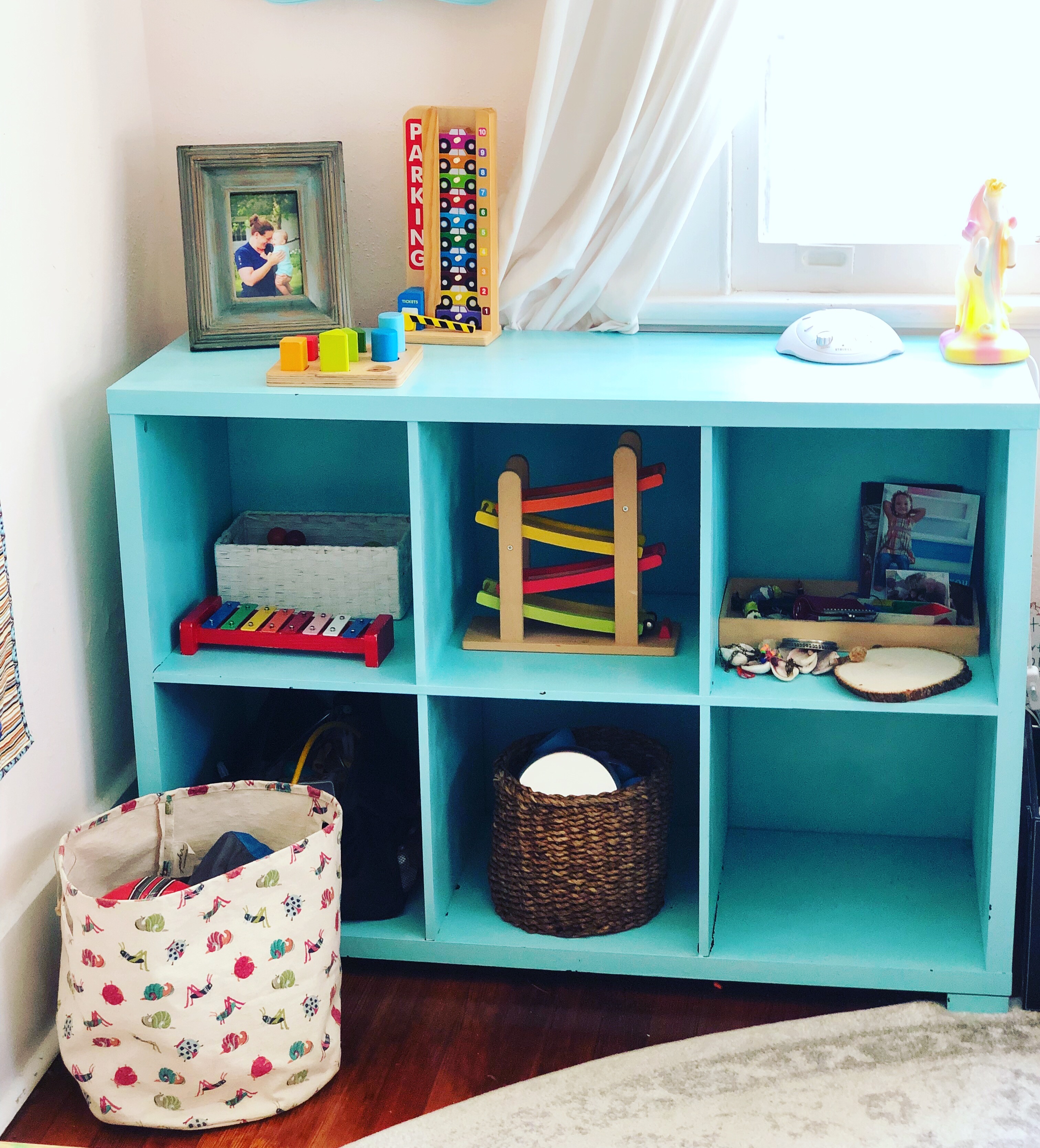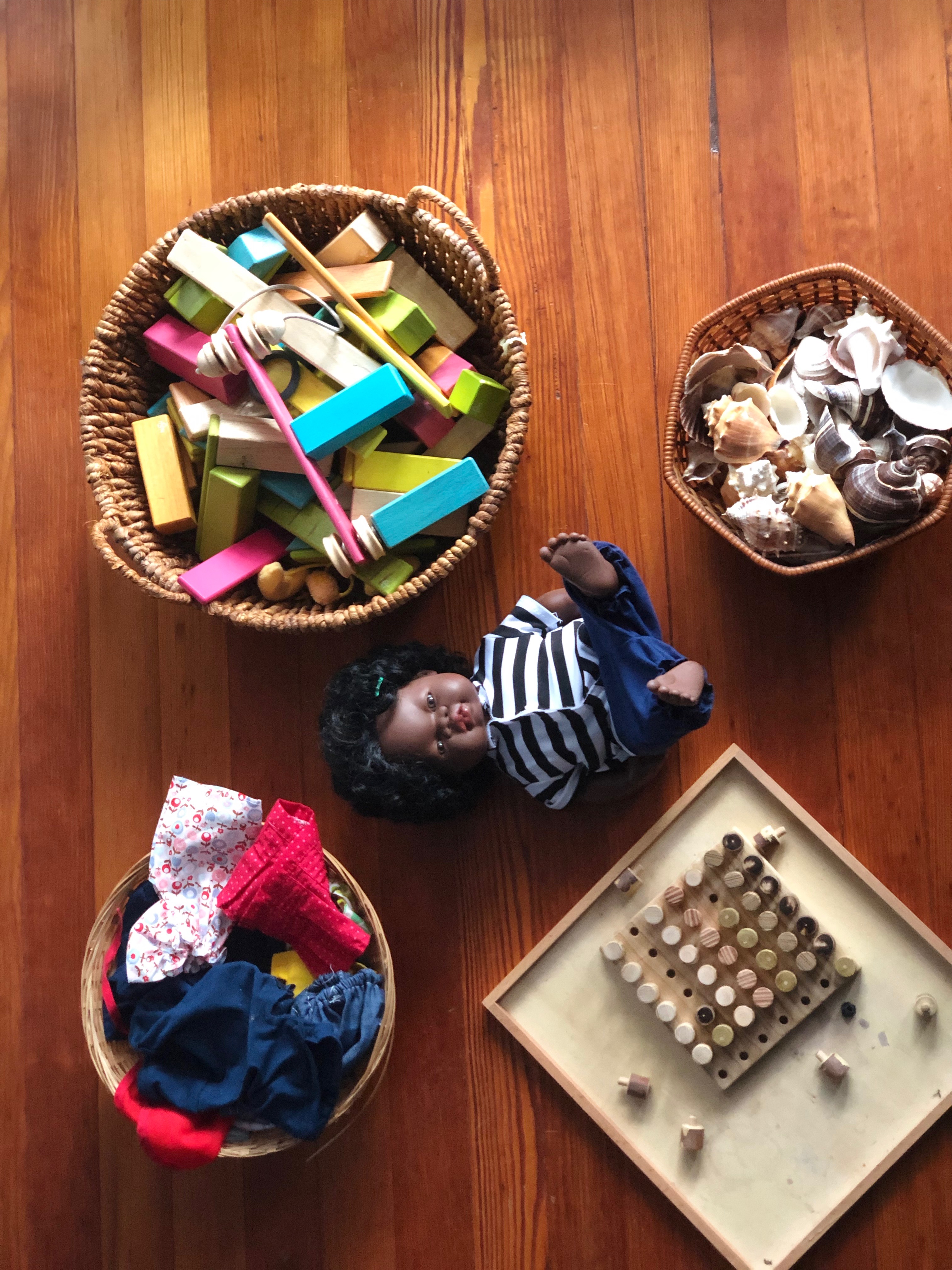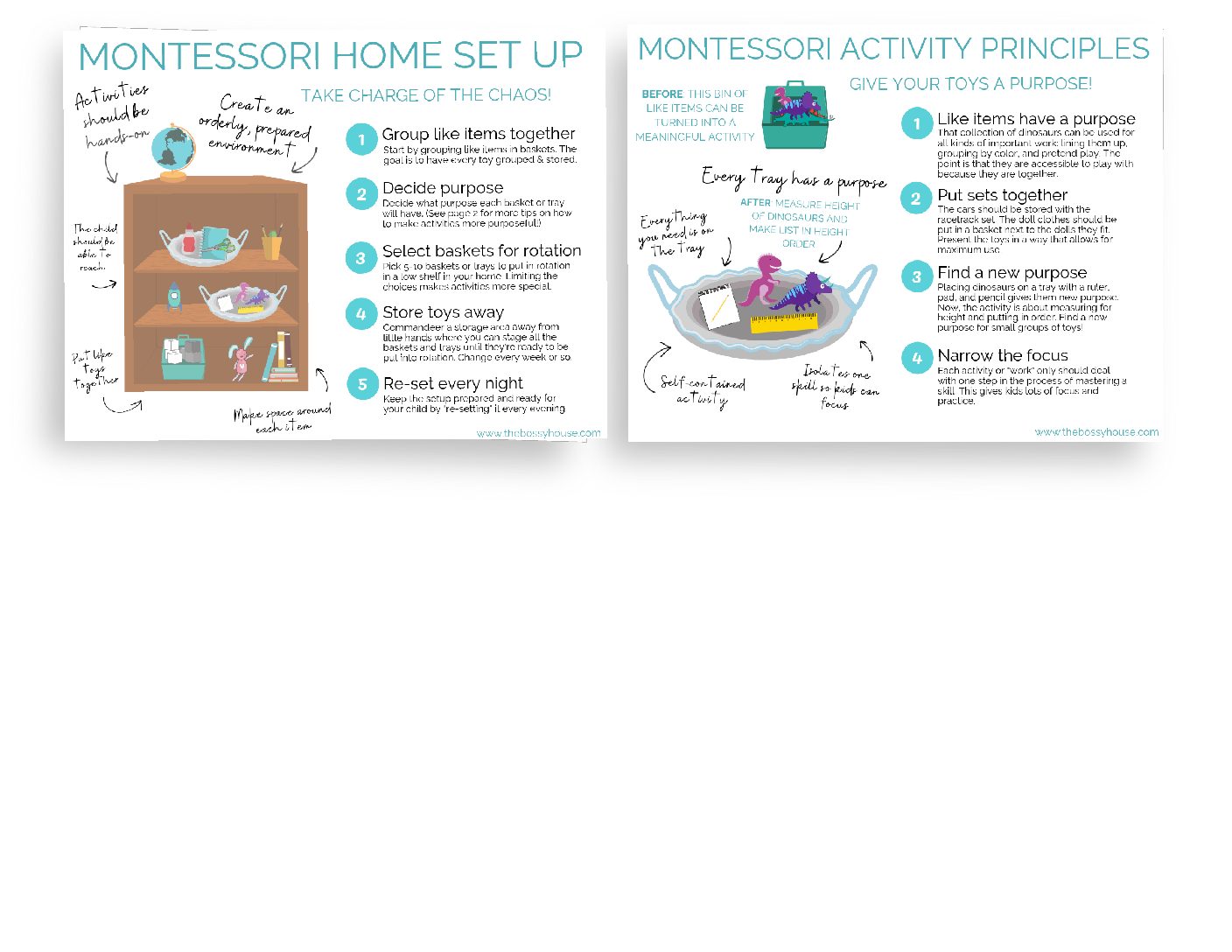
THIS POST MIGHT CONTAIN AFFILIATE LINKS. MY DISCLOSURE POLICY GIVES YOU MORE DETAILS.
What makes something Montessori, and how can you implement Montessori at home? This is what I’m asked all the time by parents who see the benefits of a Montessori education and want to bring those principles home.
I’ll tell you, it's not buying wooden toys. It’s not about eschewing those Peppa Pig toys. It’s not even about rolling out the Montessori mat (surprise-- we don’t use one at home!). It’s about beliefs about what education should be about, and a set of guiding principles about how teaching should be done.
There are basic Montessori ideas on education that make up the foundation for implementing Montessori at home. Below, I give you my favorite concrete ways to bring a Montessori-inspired set up to your home.
As a Montessori school principal and mom, I have built a Montessori environment in formal and non-formal settings. Read on to learn the ideas behind the Montessori philosophy and how you can incorporate them into your life at home (whether you home school or not).
1. Involve Children in the Life of the Home and the Real World
Montessori kids are famously hammering with real hammers, learning to cut produce with knives, and generally freaking their parents out with the “real world” tools they use at school. Montessori teachers know that children are capable of learning to use real tools, and helping them learn how to use a broom, a shovel, a screwdriver, and a compass are all ways to help them learn about their world.
“The exercises of practical life are formative activities, a work of adaptation to the environment. [This] is the very essence of a useful education.”
-Maria Montessori
At Montessori schools, kids open their own milk, sweep up when they’ve made a spill, and unload the dishwasher.
In every way you can, try to encourage your child to take on roles in the family that involve real work and independence.
They are real people, after all, and are curious and interested in doing the real work that they see you do every day. Doing Montessori at home means building their independence with all the ways that we take care of ourselves and our home.
Montessorians call these “practical life” skills. Washing dishes, sweeping up, folding towels, and matching socks are all considered supremely important skills to learn at a young age.
Take advantage of your child’s interest in the practical aspects of life by giving them the job of matching socks, washing the cups, or sweeping the deck. The work might not be perfect, but your child will love being a part of the family by taking on this kind of work.
RELATED: 3 Reasons Your Kids Need Chores
In addition, it’s important that your child have independence in the home as much as possible. Their toothbrush can be at their eye level, along with a cloth for washing their face and their toothpaste. In the kitchen, put the child’s snacks at eye level in the pantry so they can get their own.
Tips for involving children in the real world life of the home
2. Create an Orderly Prepared Environment
First, a word on what the “prepared environment” is. A Montessori school is a place where the classroom(s) contain materials prepared for the child so that it’s easy to interact with the environment and build skills and knowledge about the world. The teachers spend a TON of time making that environment ready and available for kids learning.
At home, you too can prepare your environment for learning. Making it work to bring Montessori at home is something that you get to customize in a million different ways for your family.
This isn’t just about making sure things are clean (though that’s a nice bonus).
The prepared environment is deliberate
In general, the Montessori environment is very deliberate. Extraneous things are removed so it’s clear what we’re focusing on, and visual clutter is eliminated. Your home doesn’t have to be a minimalistic paradise to still be Montessori, but you do need to consider that clutter creates a lack of focus.
You can start by just thinking about making the learning and playing environment as orderly as possible. This means limiting the number of items on a shelf and putting visual space around each item so the child can see that it’s separate from other items.
This kind of shelf situation can seem “precious” -- that’s because we are treating each object as a precious item that deserves its own space.

Contrast that with the opposite philosophy: piles of toys, parts to a game missing, doll clothes on one side of the room and piles of naked dolls everywhere. When children play in these environments, there’s a sense of the meaninglessness of the toys because they aren’t able to be fully engaged with because first you have to find all the parts! In addition, the purpose of each item is diluted when they aren’t grouped together.
For example, the fun (and the skill!) of dressing dolls happens when there are several choices of clothes to pick from and the child selects an interesting-to-them combination. Then, maybe, they take those clothes off and put new ones on, and so on. This purposeful play (that involves visual discrimination, fine motor skills, creativity, and discovering the purpose of each item of clothing) doesn’t really have the same purpose when the clothes aren’t in the same place and the doll that fits those clothes nearby.
Each work should have a purpose
So to make the environment ready for focusing on the important purpose of the work (and toys) you have provided, creating groups of items allows for them to be worked with well.
So all the Beyblades should go together in a basket so, when it’s time to battle, they’re available. A puzzle should have all its parts and be collected together on a tray so that your child can just pick up the tray and begin to work with the puzzle.

In addition to grouping like things together, putting things away is made easier because your child can easily see where things go.
Encourage them to put away the activity they’re working on when they are finished working. This makes it easier for them to engage fully in the next item. In my house, I have a three basket rule. Once three baskets are out, we have to put one away before getting out a fourth.
When you are considering what items to put out for your child, try to think about what the purpose is. That way, you can get all the materials needed close by so the child can do the work without much searching. For example, you might have a letter writing work contained on a tray. You’d include paper for writing letters, two pencils, and a pencil sharpener, plus a laminated sheet of letters to copy. You don’t want crayons, scissors, and tape on that tray unless those things are a part of the intention for the letter writing work.
You help your child focus on a task by narrowing the items on the tray. This would be an invitation to write letters without the distraction of other items.
Tips for creating an orderly, prepared environment
3. Give Limited Choices to Build Independence
All of us love to have choices about our environment. Kids are the same way! Letting them pick what to work with is a part of implementing Montessori at home. Your child’s learning is improved when they are picking work that interests them and there are choices that are limited but engaging.
As with everything Montessori at home, you will implement this in your own way.
Some families have a list of possible work assignments for the day and have kids create their own list. Others give limited choices about clothes every morning to give their child a way to choose for themselves what they wear. We’re not talking about unlimited choice! We are taking six snacks we’d let our kids have and putting them in a bowl and saying “you choose.”
This part of the philosophy is so key to your child developing interests for themselves and independence in their world. If we make all the choices for kids, they don’t develop their own drive in the world. Similarly, if we do everything for them, they don’t develop the skills to take care of themselves.
"Never help a child with a task at which he feels he can succeed."
-Maria Montessori
In my house, I have dishes for my daughter in a low drawer, and food she eats on her shelves in the fridge and pantry. Each evening, she gets her dinner from those choices. Often she’ll ask me to make pasta, but for the most part she combines apples, cheese, cucumber, hard boiled eggs, and blueberries to make a dinner for herself.
You will find ways to make limited choices available to your child so they can find ownership and independence in your home.
Tips for giving choices and building independence
4. Provide Hands-On Activities
If you’re going to do Montessori at home, you’ll need to understand this idea of concrete learning to build a foundation for abstract thinking. In every case with Montessori curriculum, concrete and hands-on materials help make abstract concepts clearer for kids.
This means that your work and play shelves should have lots of concrete hands-on items that give kids physical opportunities to manipulate the materials.
Yes, you could put worksheets on trays and call it a day. But the point is that kids need to physically touch the number of items they are counting to help make sense of numbers. They need to use their hands and their bodies to internalize the abstract concepts of math and letter awareness.
Tips for prviding hands-on activities
With these ideas about how you can implement Montessori at home, you are well on your way to creating a prepared environment for your child to learn and grow, right at home!
Get this two-page Montessori Set Up Guide to get started setting up your home with Montessori principles!


